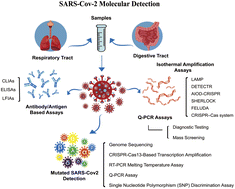Current strategies for SARS-CoV-2 molecular detection
Abstract
The molecular detection of SARS-CoV-2 is extremely important for the discovery and prevention of pandemic dissemination. Because SARS-CoV-2 is not always present in the samples that can be collected, the sample chosen for testing has inevitably become the key to the SARS-CoV-2 positive cases screening. The nucleotide amplification strategy mainly includes Q-PCR assays and isothermal amplification assays. The Q-PCR assay is the most used SARS-CoV-2 detection assay. Due to heavy expenditures and other drawbacks, isothermal amplification cannot replace the dominant position of the Q-PCR assay. The antibody-based detection combined with Q-PCR can help to find more positive cases than only using nucleotide amplification-based assays. Pooled testing based on Q-PCR significantly increases efficiency and reduces the cost of massive-scale screening. The endless stream of variants emerging across the world poses a great challenge to SARS-CoV-2 molecular detection. The multi-target assays and several other strategies have proved to be efficient in the detection of mutated SARS-CoV-2 variants. Further research work should concentrate on: (1) identifying more ideal sample plucking strategies, (2) ameliorating the Q-PCR primer and probes targeted toward mutated SARS-CoV-2 variants, (3) exploring more economical and precise isothermal amplification assays, and (4) developing more advanced strategies for antibody/antigen or engineered antibodies to ameliorate the antibody/antigen-based strategy.

- This article is part of the themed collection: Analytical Methods Review Articles 2022


 Please wait while we load your content...
Please wait while we load your content...